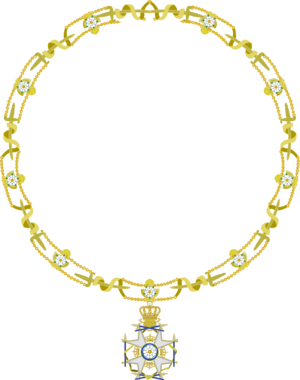Order of the Rose (Aquitayne)
| The Most Noble Order of the Rose | |
|---|---|
 Collar of the Most Noble Order of the Rose | |
| Awarded by Sovereign of Aquitayne | |
| Type | Order of chivalry |
| Established | 1381 |
| Motto | NON DUCOR DUCO (’I am not led; I lead’) |
| Awarded for | Service, at the monarch's faith |
| Status | Currently constituted |
| Founder | Augustus I |
| Sovereign | King Samuel I |
| Lord Master | Queen Lori |
| Grades | Knight/Dame Grand Cross (GCR) Knight/Dame Commander (KCR/DCR) Companion (CR) |
| Precedence | |
| Next (lower) | Order of the Griffin |
The Most Noble Order of the Rose is an order of chivalry founded by King Vrandys III of Aquitayne in 1381. It is the most senior order of knighthood in the Aquitaynian honors system, outranked in precedence only by the Elizabeth Cross. The Order of the Rose is dedicated to the symbol of the Reich family dynasty, the white Tudor rose.
Appointments to the Order are made at the sovereign's sole discretion. Membership to the order is limited to the Sovereign, the Duchess of Acril, and no more than 30 living members, or Companions. The order also allows for supernumerary knights and ladies (e.g members of the royal family and foreign royals). Originally the order was only granted to citizens of Aquitayne, however a royal patent in 1542 by King Hadrus I allowed the order to be given to foreign royals, namely the Exponents. This patent was later reversed by Augustus I, and then re-instated by Elizabeth I in 1841.
The order's emblem is the white Tudor rose, with the motto Non Ducor Duco ("I am not led; I lead") in gold lettering. Members of the order wear it on ceremonial occasions.
History
Origins
Composition
Members
Membership in the Order is severely restricted, and new members are added at the sole discretion of the monarch. Members of the Order include the sovereign, the Duke of Acril, not more than 28 companion members, and various supernumerary members. The Monarch alone grants membership into the Order and is known as the Lord Commander and Protector of the Rose, and the Duke of Acril is known as a Royal Knight Commander of the Rose.
Male members of the Order are titled "Knights Commander" while female members of the Order are titled "Ladies Companion". In the original standard of the Order before it was disbanded by Augustus I, the monarch would take nominations from established members of the Order to fill vacancies. The nominations put forward must have met specific criteria. Namely, the individual must hold a royal rank of at least an earl, or at least have already been knighted. The Sovereign would then decide who would fill the vacancies. According to historical records, this was done for a practical reason. The Order gave legitimacy, honor, and stature to those who belonged to it - because of this, no one member wanted the Sovereign to appoint only those loyal to them to its ranks.
When the Order was re-established in 1841 by Queen Elizabeth I, she amended the Orders patent by ensuring the monarch had sole discretion over new additions when vacancies arose. To this day, appointments to the order are decided solely by the monarch and are considered personal gifts. In 1972, Parliament attempted to force the Sovereign to take the advice of the ministers on new appointments, but the bill did not pass through committee.
Supernumerary members
Degradation
Officers
Precedence and privileges
Members of the order are assigned positions in order of precedence, coming before all others of knightly rank and above Barons. The immediate family of members, such as the sons, daughters, and wives, are also awarded precedence. This precedence does not, however, preclude the member from adhering to regular customs when addressing those of a higher rank than themselves, such as a Count or Duke.
Knights Companion prefix "Ser" and Lady Companions prefix "Lady" to their names. Wives of Knights Companions may prefix "Lady" to their name as well, but no corresponding privileges are ever extended to husbands of Lady Companions.
Knights and Lady Companions use the post-nominal letters "CR" and "LR" respectively. When an individual is entitled to use multiple post-nominal letters, the Order of the Rose is displayed before all others except the Elizabeth Cross.
In their heraldic acheivements, members may add the rose to their escutcheon.

